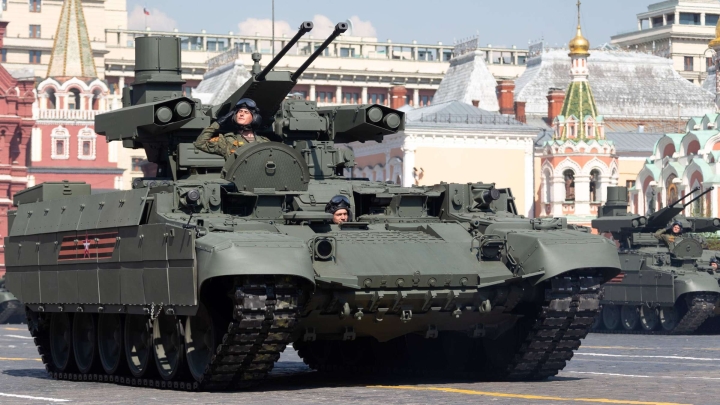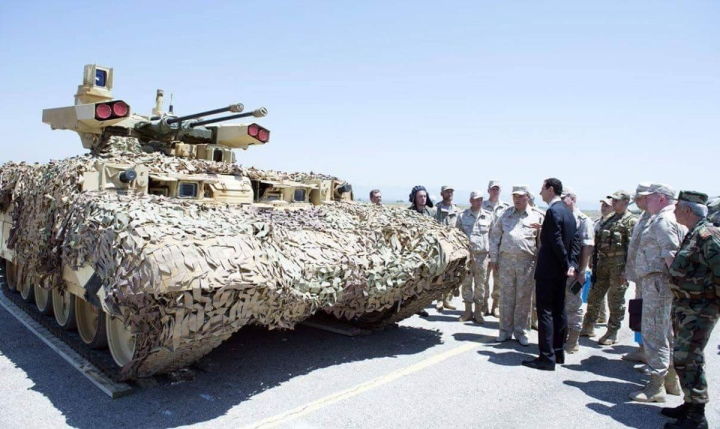Russian armored “Terminator”
The defense industry corporation UralVagonZavod has begun to deliver a series of BMPT-72 Terminator-2 tank support combat vehicles – the “killer” to the Russian army and gradually assigned to armored units. mainstay.
Commenting on the Russian military’s mass introduction of the BMPT-72, former Colonel Mikhail Khodarenok said that recent local wars and armed conflicts show armored fighting vehicles operating in Urban areas or complex terrain are always easy prey for anti-tank grenade launchers (RPGs) and anti-tank guided missiles (ATGMs).
To address this concern, the design engineers at UralVagonZavod have developed a special tank support combat vehicle that helps armored units eliminate the threat posed by enemy infantry forces that are inherently known to be enemy troops. equipped with RPG and ATGM.

Combat vehicles supporting BMPT-2 tanks participate in the parade on Red Square. (Photo: Frankfurter Rundschau)
BMPT-72 is basically designed to work with tank or mechanized infantry units in a common tactical formation, its main task is to eliminate threats from enemy infantry as well as attack. public other goals.
The design of the BMPT-72 builds on an upgraded version of the original BMPT, both using the T-72 tank chassis.
The combat weight of each BMPT-72 is 44 tons, its main armament is two 30mm 2A42 automatic cannons (850 rounds), 7.62mm PKTM coaxial machine guns (2,100 rounds), automatic grenade launchers 30mm AGS (600 rounds) and a combination of four Ataka-T guided anti-tank missiles.
Compared to the first BMPT version, Terminator-2 only needs a crew of 3 to operate.
According to Khodarenok, it is not easy for armored fighting vehicles like the BMPT to gain a foothold in the Russian military, which operates too many main battle tanks and infantry fighting vehicles, its being put into commercial production. series has partly shown the role of BMPT on the battlefield in the future.
It should also be added that the development of such an armored vehicle as the BMPT has been carried out since the time of the Soviet Union and then Russia. The first tests began in 2007 but at that time the Russian military had not yet decided how and under what circumstances the BMPT would be used.

Basic weapon systems on a BMPT-72. (RIA photo)
In addition, there were mixed opinions about this project from the heads of the Russian Defense Ministry at that time, it is completely understandable that the Russian military hesitated to put into equipment the BMPT early.
Luck once again smiled at the BMPT as it was tested in Syria. A small number of vehicles have been sent by the Russian military to the war zone, where they have demonstrated their ability to provide fire support to Russian armored and ground forces and also to the Syrian army. The operation of the BMPT-72 in Syria has changed the view of Russian generals about this new weapon.
How will Russia use the BMPT-72?
Returning to the question of how the Russian military will use the BMPT-72 and under what circumstances, Khodarenok thinks it will follow specific directions.
The first, Tank-supporting combat vehicles can now operate in a joint tactical formation with the tank. Previously, the Russian military did not have any armored fire support equipment that possessed the strength and defense capabilities of a tank.
According to the Russian military’s armored training program, armored fighting vehicles that support firepower of motorized infantry often have to operate from 100-200m behind the attacking nose of the tank, which is unintentional. creating a gap that allows the enemy to neutralize the tanks ahead with anti-tank weapons.

BMPT-72 during testing in Syria. (Photo: Russian Defense Ministry)
Meanwhile, with the BMPT-72, moving in tandem with the tank attack on the front line allows to eliminate threats from enemy infantry, as well as create opportunities for tanks in the formation to destroy the enemy. enemy armored target.
With the prevalence of hand-held anti-tank weapons among modern infantry units and even rebel or terrorist groups, neutralizing enemy infantry now requires a combination of of different types of vehicles.
The combat effectiveness of armored battalion-level battle groups consisting of one tank battalion and one BMPT-72 company is expected to increase by 15-25%, depending on the type of operation. However, to increase efficiency in the coordination between tanks and support vehicles, it is necessary to conduct joint training and exercises between units.
There are different types of tactics developed for tank support combat vehicles, they can be used offensively or defensively, fighting independently from the enemy to defending outposts from afar.
Monday, The introduction of a completely new weapon model like the BMPT (which has never been seen before) will create many difficulties for training and technical logistics. This forced the Russian army to make certain changes in the logistics system associated with armored units or motorized infantry.
Based on the experience and research accumulated from the Soviet Union and later Russia on combat support vehicles, after the success of the BMPT-72, UralVagonZavod continued to launch another vehicle named AU-220M Baikal, is expected to be mounted on the Armata multi-purpose crawler chassis (with an unmanned combat module) and armed with a 57mm 2A91 automatic cannon.
This artillery complex is remotely controlled and can be mounted on various armored chassis including older models as a way to increase combat effectiveness. Thanks to its armor-piercing ammunition, the 57mm (2A91) cannon can neutralize most existing armor – it also comes with a wide range of ammunition allowing it to take on a low-altitude anti-aircraft role.
at Blogtuan.info – Source: danviet.vn – Read the original article here
